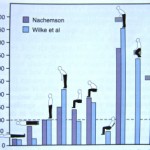The Tiger's Mouth Blog
Notes sur l’anatomie et la physiologie : Introduction
Article #1 Article original en anglais publié le 13 mars 2010 Traduction française, révisée et approuvée le 23 janvier 2011 Depuis quelque temps, on m’encourage à publier régulièrement une série d’articles sur le site Web international de la Société de tai chi taoïste. J’entreprends ce projet aujourd’hui même. Ces notes devraient refléter ce que j’ai […]
Note on Anatomy and Physiology: Suppleness of Focus
We’ve concentrated a lot lately on the upper limbs. We’ve emphasized that, because the hands form one end of a number of continuities running through the body, their proper use has a significant impact on all our movements. But the hands, although intimately connected to the centre, are situated out in the periphery. While they […]
Notes on Anatomy and Physiology: Slings at the Front, Slings at the Back
For awhile now, we’ve been delineating hand to foot continuities that run throughout the body, providing strength, flexibility and a more developed sense of one’s body in space as they unfold. These patterns of uninterrupted flow, created by sequences of muscle, tendon, fascia and bone, come and go with movement. We saw, last time, how motion […]
Notes sur l’anatomie et la physiologie : La dégénérescence des disques
Article #13 Article original en anglais publié le 7 juin 2010 Traduction française, révisée et approuvée le 12 oct. 2010 Nous poursuivons l’examen des disques intervertébraux commencé dans l’article précédent de ce blogue. Nous aurons ainsi l’occasion d’examiner certains des changements normaux associés au vieillissement de la colonne et d’aborder la question de la discopathie […]
Notes sur l’anatomie et la physiologie : La sténose rachidienne
Article #14 Article original en anglais publié le 10 juin 2010 Traduction française, révisée et approuvée le 12 oct. 2010 Dans le dernier article, nous avons examiné la discopathie dégénérative dans la colonne lombaire, un problème fréquent chez les humains de nos jours. Compte tenu des nombreuses pièces mobiles qui forment la colonne, il n’est […]
Notes sur l’anatomie et la physiologie : Les ligaments rachidiens – Maintenir toutes les parties ensemble
Article #15 Article original en anglais publié le 21 juin 2010 Traduction française, révisée et approuvée le 12 oct. 2010 Jusqu’ici, on a présenté un aperçu d’un certain nombre des éléments de la colonne vertébrale – les vertèbres, les disques intervertébraux et les articulations des facettes vertébrales. Nous avons examiné brièvement la maladie des disques […]
Notes sur l’anatomie et la physiologie: les facettes vertébrales de la colonne
Article #11 Article original en anglais publié le 24 mai 2010 Traduction française, révisée et approuvée le 12 oct. 2010 Les derniers articles mis en ligne portaient sur des aspects particuliers de la colonne vertébrale et des vertèbres. Celui d’aujourd’hui examine plusieurs caractéristiques des facettes vertébrales, des structures reliant les vertèbres qui donnent sa stabilité […]
Notes sur l’anatomie et la physiologie : Les disques intervertébraux
Article #12 Article original en anglais publié le 1er juin 2010 Traduction française, révisée et approuvée le 12 oct. 2010 Les disques intervertébraux jouent un rôle clé dans la vie d’une colonne vertébrale saine. Leur dégénérescence est une cause fréquente de douleur et d’invalidité, et une hernie discale lombaire est à l’origine de la plupart […]
Notes on Anatomy and Physiology: The Hand and The Tiger’s Mouth
Last time, we looked at how the bones of the elbow-forearm complex are designed so that the elbow bends and the hand turns. To better understand the influence of the hand and elbow on the strength and balance of our entire structure, we need to consider the ties binding the components of the upper limb […]
Notes on Anatomy and Physiology: One Big Tendon
In an earlier article, it was mentioned that we are often asked in class to open Tiger’s Mouth, bring fingertips up, drop elbow, turn wrist or send out the hands. Why is that? What role do the upper limbs play in learning our art? How do they contribute to the balance and strength of our […]
Notes on Anatomy and Physiology: The Elbow-Forearm Complex
In practicing our art, one of the things we discover is the steady rhythm of the body as it turns up and then down. Surprisingly, we also learn that attending to the placement of the hand and elbow helps us acquire that rhythm. We will focus today on the elbow-forearm complex, its anatomy and its […]
Notes on Anatomy and Physiology: Learning with the Hand and Elbow
Taoist Tai Chi® arts introduce a way of moving that is novel for all students. Because the focus is on balance in all its dimensions, we develop over time a newfound sense of comfort and ease as we practice the 108 moves of the set. It feels as if we are learning to move the […]
Notes on Anatomy and Physiology: More On The Ties That Bind
In the tor yu, the hands draw out the spine – as the body sends out the hands. To better understand this interplay, let’s examine further the whole body continuities that tether the upper limbs to the rest of the body. You recall that last time we examined the lines of pull created by the […]
Notes on Anatomy and Physiology: The Intervertebral Discs
The intervertebral discs play a key role in the life of the healthy spine. Their degeneration is a frequent cause of pain and disability, and a herniated lumbar disc represents the most common reason adults end up with back surgery. And many students first come to the Taoist Tai Chi® arts because of persistent back pain. […]
Notes on Anatomy and Physiology: Slings at the Front, Slings at the Back
For awhile now, we’ve been delineating hand to foot continuities that run throughout the body, providing strength, flexibility and a more developed sense of one’s body in space as they unfold. These patterns of uninterrupted flow, created by sequences of muscle, tendon, fascia and bone, come and go with movement. We saw, last time, how motion […]
Notes on Anatomy and Physiology: Function of the Thoracolumbar Fascia, Part 2
In the last note, we learned that bending forward with the low back in Step Up and Punch or Push Needle to Sea Bottom reverses the normal lumbar lordosis, lengthens the thoracolumbar fascia, tautens its fibers and stores elastic energy. We saw that simply letting the weight settle in the don yu , tor yu and set causes […]
Notes on Anatomy and Physiology: Getting the Feel of Tensegrity
We’ve spoken recently of how the body makes use of tensegrity to help hold itself together. We stretch out our soft tissues and they resist further expansion and create a sea of continuous tension that tugs on and supports the bones suspended within it. Soft tissue and bone working together. Because the soft tissues resist […]
Notes on Anatomy and Physiology: Function of the Thoracolumbar Fascia, Part 1
Today we want to take another look at the purposes served by our thoracolumbar fascia during the activities of a normal day. The first thing to point out is that western medicine has only discovered the functional significance of this fascial sheet over the last 40 years. And yet the ancient art we practice has […]
Notes on Anatomy and Physiology: Spinal Stenosis
Our most recent discussion concerned degenerative disc disease in the lumbar spine, a problem common to modern-day humans. Given the many moving parts that make up the spine, it is not surprising that there are a number of causes for low back and leg pain. The spinal cord and its meningeal wrappings, the vertebrae themselves, the facet […]
Notes on Anatomy and Physiology: Degenerative Disc Disease
Let’s continue with the examination of intervertebral discs begun in the last post. This will also give us a chance to examine some of the normal changes associated with aging of the spine and to have a look at degenerative disc disease, a difficulty frequently encountered in the lumbar region. Many mysteries remain about how […]
Showing results





